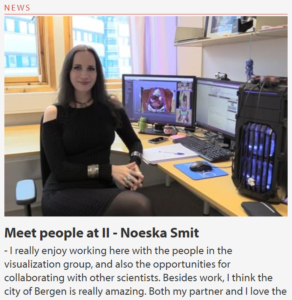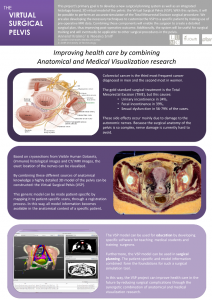So I have fallen off the blogging bandwagon more often than I can count, but maybe sparse updates are better than zero updates? I don’t even no where to begin, so why not have a little bullet point list of big life changes:

- I became a mom in 2022. Words can’t express what an impact on my life this change has had. In Norway we get one year of parental leave, so I basically took a break from work for a year that in many ways wasn’t so much a break, but rather a life-altering role change. I try not to post his cute little face online for various reasons, but here is a glimpse of us in Bergen. He is much bigger now of course!
- I received tenure January 2023. So I successfully completed the tenure track and officially became a tenured full professor in medical visualization. This happened while I was very busy being a mom, so this change sort of went under the radar for me. Apparently, I was the first at our University to do this though, so there was a nice interview and lots of congratulations from my dear colleagues. Now that I am back at work, it does feel different in that a lot of the pressure to build my tenure portfolio is gone, so that I can engage in things that are meaningful and add value during a larger part of my time than before.
- Work-life balance. Becoming a mother has also impacted this area of my life. I get two hours a day off for breastfeeding (paid! <3 Norway, the best country ever and also my employer). In addition, we need to bring the bundle of joy to kindergarten and pick him up at a reasonable hour. Then when I am home, there is no change to work due to caregiving responsibilities and sleep trouble. This forces work-life balance like nothing else, there is just not a chance to work outside of my reduced working hours. This means downscaling, in particular, my expectations of what I can do. It also means feeling like I am failing as a researcher, as a mom, and/or as a partner a lot of the times in a variety of configurations.
- Productivity tools. I have been a loyal Evernote user for about 12 years. I used it for everything, recipes, lab journal, travel planning, deciding what eyeshadow is worth buying (yes really), etc. But given the recent subscription price hike and what they did to the free tier features (“Take great notes, Create up to 50 notes and 1 notebook”, … There is nothing great about this whatsoever, Evernote!), we had a rough break up. The break up was significantly eased by a smooth transition to Obsidian. Exporting and importing 12 years of life notes was surprisingly easy and I love everything about Obsidian. I also separated personal and work-related notes into their own vaults. Perhaps someday a blog post of its own? For recipes, my friend StefanV recommended Paprika and this is really the best thing to ever happen in my kitchen.
I think it is lunch o’ clock soon, so going to wrap this up without any good concluding statement whatsoever.



